 |
Sewerage system improvement |
|
|
| To build a community that is not susceptible
to impact of rain |
The Osaka Plain is an alluvial plain created by accumulation of earth
and sand, etc. from the Yodogawa and other rivers. For this reason, approx.
90% of Osaka City area (with the exception of Uemachi-daichi Plateau,
etc.) is susceptible to the impact of rain, necessitating water displacement
by pumps.
Although the sewerage of Osaka City covers almost 100% of the area, flooding
occurs even today in times of localized torrential rain.
For this reason, Osaka City is committed to building sewerage trunk lines
as well as expanding new and existing pumping facilities in an effort
to create a flood-free community where safety and amenity are ensured.
Other fine-tuned measures include installation of manhole pump systems
for local discharge. |
| |
 |
| |
| To create an urban environment with enhanced
amenity |
| To protect the global environment and build a community with enhanced
amenity and attractiveness, Osaka City promotes recycling of sewerage
resources and energy (including treated water, sludge and heat) as well
as aboveground space of sewerage facilities, etc. |
| |
| Tree diagram of sewerage system resources |
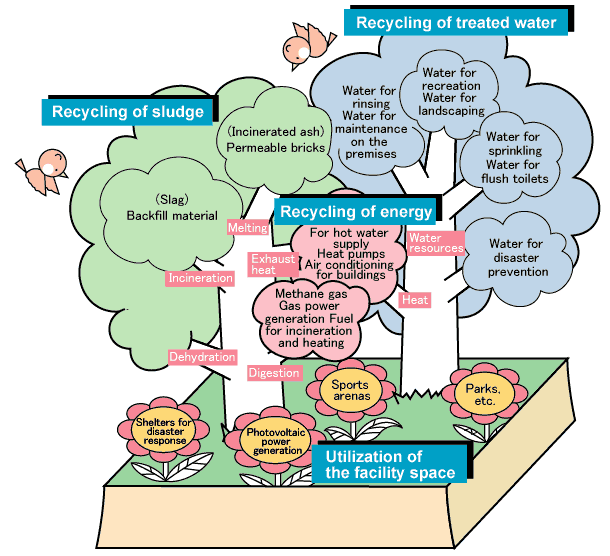 |
| |
| To put in place a better sewerage system
for the next generation |
Sewerage improvement projects undertaken by Osaka City were launched
in the Meiji period (1868-1912). Due to their long operation, the condition
of a growing number of sewerage facilities has deteriorated.
If these deteriorated facilities were left unattended, it would lead
to problems including: collapse of roads due to damaged sewer pipes;
decline in operating capacity of equipment at pump stations and sewage
treatment plants; increase in maintenance costs.
To maintain sewerage facilities properly and efficiently, these deteriorated
facilities will be rebuilt and renovated systematically to meet social
needs. |
| |
| Inventory of deteriorated facilities
(as of the end of FY 2004) |
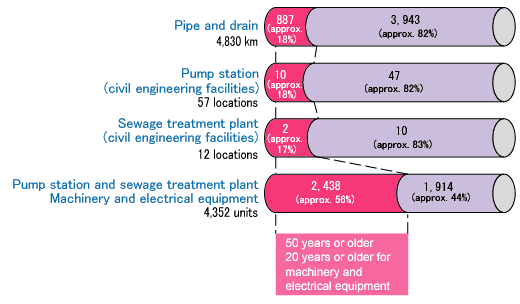 |
|
| Deteriorated sewer pipe / drain |
 |
 |
| Renovated sewer pipe / drain |
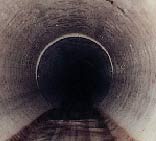 |
|
|
| |
| To create a clean water environment |
Wastewater from households, etc. is cleaned at sewage treatment plants
before released into the rivers and the sea. Thus sewerage is designed
to safeguard the quality of natural waters as well as the environment.
In Osaka City, complete treatment is performed at all the sewage treatment
plants. Water quality of rivers in the city has improved significantly
since around 1970 when the sewerage system was extensively developed.
However, some of the rivers have not met environmental standards on water
pollution. In addition, Osaka Bay suffers red tide every year.
Most areas of Osaka City are serviced by combined sewerage systems where
rainwater and wastewater (from households and corporate entities) are
collected in the same sewer pipes. Combined sewerage systems have one
drawback, however. When intensity of rain exceeds a certain limit, some
pollutants and waste, etc. flow directly into rivers together with the
rainwater, which results in water pollution.
To meet environmental standards on water pollution and create a cleaner
water environment, Osaka City is working on construction of remedial
facilities for combined sewerage and advanced treatment facilities as
well. These efforts are intended to improve water quality of the Dotonbori-gawa
and Higashi-Yokobori-gawa Canals.
In addition, all the sewage treatment plants will be connected by piping
to transport and treat sludge efficiently. With completion of the phase
I construction project, "Maishima Sludge Center" (an intensive
sludge treatment facility) will also undergo further development. |
| |
| Improvement in combined sewerage system and advanced
treatment |
 |
| |
| Water purification measures at the Dotonbori-gawa
and Higashi-Yokobori-gawa Canals |
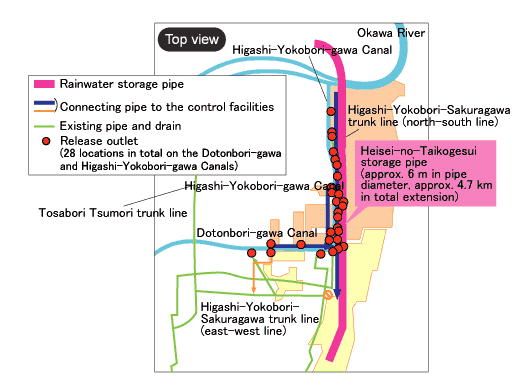 |
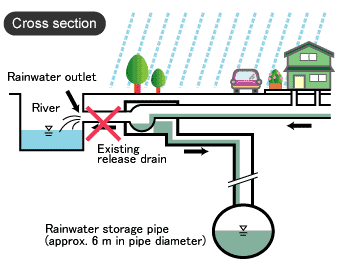 |
| |
| Sludge pipe transportation map |
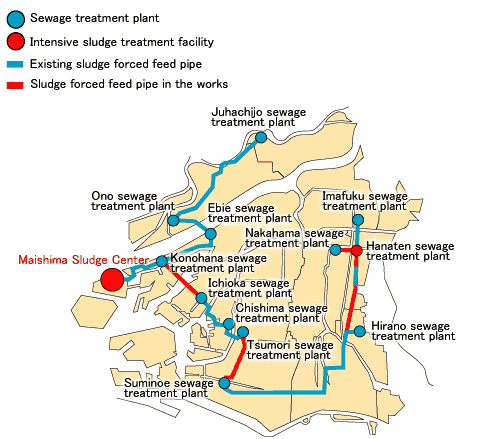 |
| |
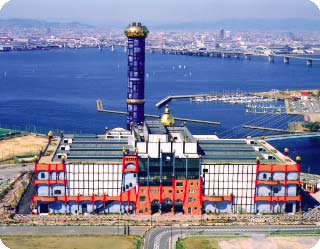 |
| Maishima Sludge Center |
|
| |
| Building an earthquake-resistant sewerage
system |
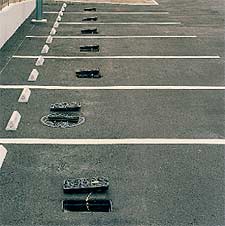 |
Wastewater receiving
facilities for
temporary restrooms |
Like water, electricity and gas, the sewerage system is one of the
lifelines that support citizens' life.
For this reason, arrangements must be made so that sewerage facilities
sustain their operations and serve as disaster prevention facilities
when disasters such as an earthquake occur.
To this end, sewage treatment plants and other buildings are reinforced
based on earthquake resistance investigations. Efforts are also made
to fully equip facilities with private power generation units. In addition,
Osaka City will improve wastewater receiving facilities for temporary
restrooms at area-wide shelters, etc. as well as fire prevention and
daily life water supply equipment that makes use of advanced treatment
water recycled from sewage. |
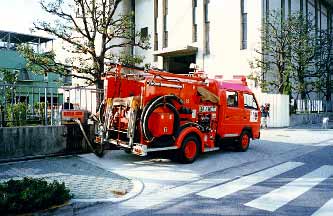 |
|
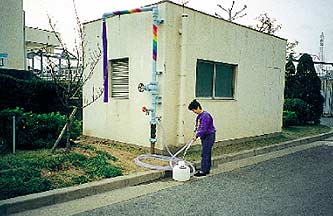 |
| |
|
Fire prevention and daily life water supply equipment |
|
| |
| To improve efficiency of administration |
| Remote supervision and control |
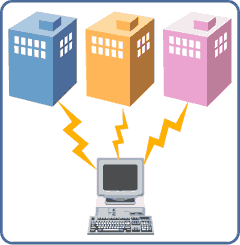 |
Efforts are made to improve efficiency of administration. For example,
a remote supervision and control system will be established to enhance
efficiency in maintenance of sewerage facilities, and integrate and centralize
the monitor room. When deteriorated facilities are rebuilt and renovated,
they will be consolidated based on a scrap-and-build scheme. |
| |
| To ensure safety of the sewerage system |
To expect the sewerage system to work properly, it is necessary to maintain
the facilities (including sewer pipes, pump stations and sewage treatment
plants) correctly at all times.
Sewer pipes have to be cleaned, repaired or replaced to ensure smooth
flow of sewage. Day-to-day inspections are also indispensable.
Sewage continues to flow into the facilities day and night. Furthermore,
localized torrential rainfall is not predictable. Under these circumstances,
the staff must control operation around the clock at pump stations and
sewage treatment plants. It is also imperative to inspect and repair
facilities. Efforts are also made to maximize efficiency of operation
to meet ever changing water volume. |
| |
| Checking sewer pipes with a mobile camera-equipped probe |
 |
| |
The sewerage system is our valuable asset.
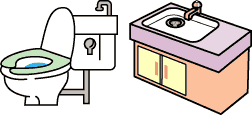 Your small-scale care saves the sewerage system. Your small-scale care saves the sewerage system.
Please refrain from discharging cooking oil and disposer-crushed
garbage from the sink, or flushing hard paper, etc. in the toilet.
Please remove waste, etc. that may clog gutters and catchment pits. |
|
| |















 Your small-scale care saves the sewerage system.
Your small-scale care saves the sewerage system.